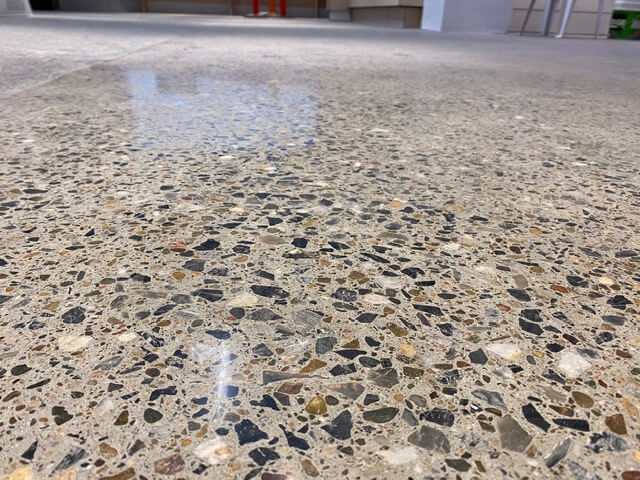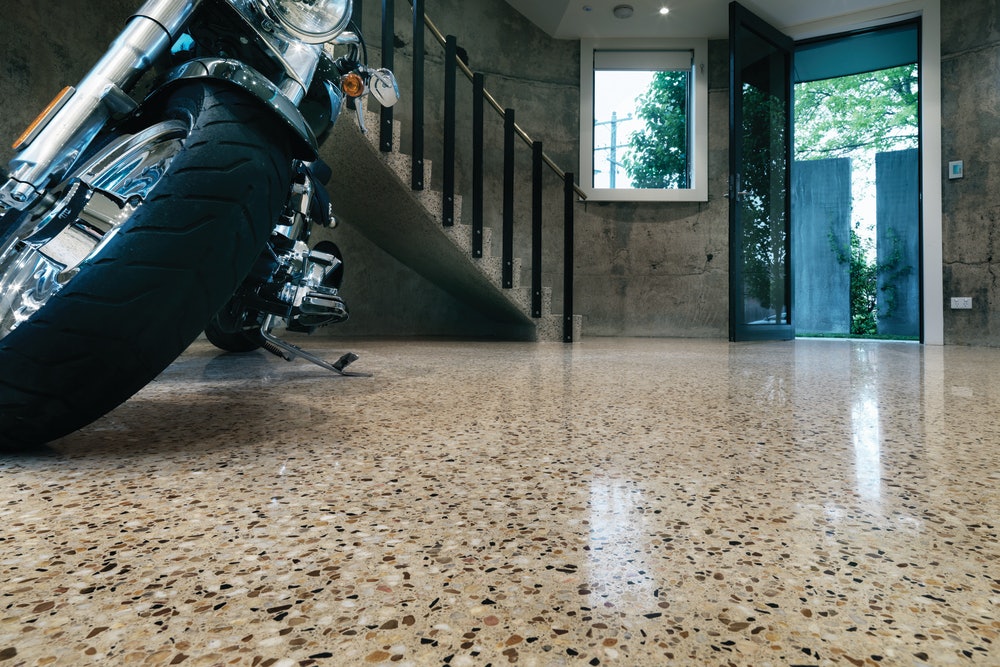Comprehensive Guide to the Solutions Supplied in Polished Concrete Floor Covering Installation
Polished concrete flooring installment includes a number of crucial solutions that contribute to a long lasting and visually attractive finish. The procedure begins with meticulous surface area preparation, guaranteeing the concrete piece is clean and without imperfections. Following this, grinding and honing strategies are utilized to achieve a smooth surface. The trip does not finish there. Understanding the numerous choices for coloring, securing, and maintenance can significantly influence the last result and long life of the floor covering.
Surface Preparation Techniques
Prior to installing polished concrete floor covering, appropriate surface area preparation is critical to assure a resilient and visually pleasing coating. This preliminary phase includes several essential actions that verify the substrate appropriates for the overlay. Initially, any existing floor treatments, such as carpet or ceramic tile, need to be gotten rid of to subject the concrete piece. Next, the surface area ought to be completely cleaned to get rid of dust, oil, and other contaminants that could impede attachment
In addition, examining the problem of the concrete is important; splits, flaws, and surface area abnormalities have to be addressed. This might include patching or leveling to create a consistent base. Moisture testing is also suggested, as excess dampness can lead to future problems. Applying a guide can improve bond in between the concrete and the brightened coating. By following these surface prep work strategies, the longevity and look of the polished concrete floor covering are significantly improved.
Grinding and Honing Processes
As soon as the surface area preparation is complete, the grinding and honing processes play an essential function in accomplishing a high-quality polished concrete surface. Grinding includes the use of specialized diamond-embedded tools to remove any type of surface area flaws and accomplish a level surface. This process is important for subjecting the concrete accumulation, which adds to the flooring's visual appeal.
Developing follows grinding and involves finer rubies to develop a smoother surface. This stage improves the concrete's appearance and prepares it for subsequent sprucing up. The grit levels used during developing are thoroughly selected to ensure a refined finish without compromising the honesty of the concrete.
Both grinding and developing require competent operators that comprehend the nuances of the concrete surface area and can adjust methods according to specific project demands. Correct execution of these procedures considerably influences the resilience and visual top quality of the last polished concrete floor.
Polishing Techniques and Equipment
A number of reliable brightening methods and specific tools are made use of to achieve a high-gloss surface on concrete floors. One of the most common method includes making use of diamond sprucing up pads, which are readily available in varying grits. These pads are mounted on flooring brightening machines that systematically grind the surface to the preferred shine.
Damp brightening is preferred for its ability to lessen dirt and reduce warm, while dry polishing is chosen for its performance in smaller spaces. Additionally, planetary floor mills are often employed as they offer even stress and rate, making sure consistent results.
Advanced devices might consist of automated or remote-controlled makers, which improve performance and reduce labor intensity. Ultimately, selecting the ideal polishing method and equipment is essential for achieving the preferred surface and longevity of the polished concrete flooring, satisfying both aesthetic preferences and functional requirements.
Tinting and Tarnishing Choices

Staining Methods Introduction
Checking out various staining techniques can noticeably enhance the aesthetic appeal of polished concrete flooring. Staining choices fall under 2 key groups: acid-based and water-based stains. Acid discolorations respond chemically with the concrete, producing abundant, variegated shades that simulate all-natural stone. They pass through deeply, resulting in a long lasting coating. In comparison, water-based stains offer a wider spectrum of colors and are easier to apply, providing a much more consistent appearance. Additionally, concrete dyes can achieve dynamic hues and are typically utilized combined with stains for added depth. Each technique can significantly change the visual characteristics of the surface area, permitting modification that fulfills certain style preferences while ensuring an unique, sophisticated search in any type of room.
Color Options Available
A diverse scheme of color alternatives is offered for boosting polished concrete flooring via discoloration and dyeing strategies. These techniques permit a variety of tones, from natural tones to dynamic shades, supplying home owners and businesses the adaptability to match their aesthetic preferences. Acid-based discolorations react chemically with the concrete, developing a variegated look that imitates natural rock. On the other hand, water-based spots provide an extra consistent color and are offered in a wider variety of shades - Polished Concrete Austin. Dyes can likewise be used to accomplish vibrant, brilliant colors, enabling intricate styles and patterns. Each alternative contributes to the total impact and sturdiness of the floor covering, making color option a necessary factor to consider in polished concrete installation
Modification and Effects
While taking into consideration polished concrete flooring, personalization alternatives for coloring and discoloring play an important duty in achieving distinct visual appeals. House owners and businesses can choose from a diverse palette of shades, enabling tailored layouts that suit their specific tastes and atmospheres. Tarnishing approaches, including acid and water-based choices, enhance the natural elegance of concrete while providing a resilient surface. Acid stains develop abundant, variegated tones, while water-based discolorations provide a broader range of colors and are more environmentally pleasant. In addition, decorative results such as metal coatings or color overlays can add depth and visual interest. This degree of personalization warranties that brightened concrete floor covering not only meets functional requirements but likewise complements the overall design vision of the area.
Sealing and Securing the Surface area
Securing polished concrete is essential for boosting toughness and preventing damage from try this web-site stains and moisture. Numerous kinds of sealers are offered, each offering distinct advantages and security degrees. Recognizing these choices is important for maintaining the honesty and look of the floor covering.
Significance of Securing
The longevity and aesthetic appeal of polished concrete floor covering substantially depend upon the application of a premium sealant - Polished Concrete Austin Tx. Sealing offers multiple objectives, mainly safeguarding the surface from spots, moisture, and abrasion. By developing an obstacle, sealers avoid the infiltration of liquids and chemicals, which can create discoloration and destruction with time. This protective layer additionally enhances the sparkle and visual depth of the concrete, adding to its overall elegance. Furthermore, correct sealing minimizes maintenance demands, making it less complicated to clean up and maintain the floor's look. On a regular basis sealed concrete floors exhibit enhanced durability, ensuring they stand up to heavy foot traffic and resist wear. Ultimately, sealing is a vital step that noticeably affects the efficiency and life-span of polished concrete flooring
Kinds of Sealers
Picking the appropriate type of sealer is necessary for maintaining the honesty and look of polished concrete floor covering. There are largely two classifications of sealers: permeating sealers and topical sealers. Permeating sealants, often silicone or silane-based, infiltrate the concrete, supplying security against dampness and discolorations while allowing the surface to breathe. On the other hand, topical sealers, such click as acrylic or epoxy, produce a safety film on the surface, improving gloss and color while offering an obstacle against wear and chemicals. Each type has its advantages; penetrating sealers are optimal for high-traffic areas, while topical sealers offer an even more visual coating. Ultimately, the choice of sealer relies on the details demands and planned use of the polished concrete flooring.
Upkeep and Look After Polished Concrete
Appropriate upkeep and care are vital for extending the life-span and appeal of polished concrete flooring. Normal cleaning is a primary demand; using a pH-neutral cleaner and a microfiber mop will effectively get rid of dirt and crud without damaging the surface. Avoid making use of severe chemicals that can dull the coating.

Dusting and sweeping ought to happen often to avoid scrapes triggered by particles. Making use of furnishings pads can additionally decrease possible damages from hefty items.
Lastly, regular expert maintenance can help identify any kind of concerns early and recover the surface to its original luster. By sticking to these care guidelines, polished concrete flooring can continue to be an eye-catching and sturdy selection for several years to come.
Cost Factors To Consider and Budgeting Tips
While preparing for polished concrete floor covering installment, it's important to evaluate numerous expense factors that can influence the overall budget. The key costs consist of materials, labor, and any type of needed site prep work. The type of coating selected-- such as matte, gloss, or look at here ornamental-- also significantly affects costs. In addition, the dimension and problem of the space will certainly influence both the amount of concrete called for and the complexity of the installment.
To manage expenditures successfully, getting several quotes from contractors is suggested. This allows contrasts of services and prices. Homeowners must also think about hidden costs, such as potential fixings to existing flooring or the need for customized tools, which can contribute to the general expenditure.
Establishing aside a backup fund for unexpected expenditures can further guarantee economic preparedness. By taking these budgeting pointers into account, one can achieve a refined concrete flooring that meets visual and useful demands without exceeding the budget plan.
Regularly Asked Inquiries
How Long Does the Entire Setup Process Take?
The setup procedure duration can vary based upon task dimension and intricacy. Generally, it varies from a couple of days to a week, including surface area preparation, grinding, polishing, and sealing stages for suitable lead to polished concrete flooring.
Can Polished Concrete Be Set Up Outdoors?
Polished concrete can certainly be mounted outdoors, as it uses resilience and aesthetic charm. Nevertheless, correct securing is crucial to protect against weather components, guaranteeing longevity and maintaining its aesthetic honesty in exterior settings.
What Sorts of Structures Are Suitable for Polished Concrete?
Polished concrete is appropriate for different buildings, consisting of domestic homes, industrial rooms, stockrooms, and industrial centers. Its sturdiness and visual allure make it a suitable selection for high-traffic areas and atmospheres calling for reduced maintenance.
Is Polished Concrete Slippery When Damp?
The inquiry of whether brightened concrete becomes unsafe when damp prevails. While it can be glossy, the level of slipperiness typically depends on the surface and texture used during installment, influencing security in various settings.
Can I Install Polished Concrete Over Existing Floor Covering?
The feasibility of mounting polished concrete over existing floor covering depends upon the type and problem of the underlying surface area. Appropriate evaluation and preparation are vital to ensure attachment and achieve a sturdy, cosmetically pleasing surface.